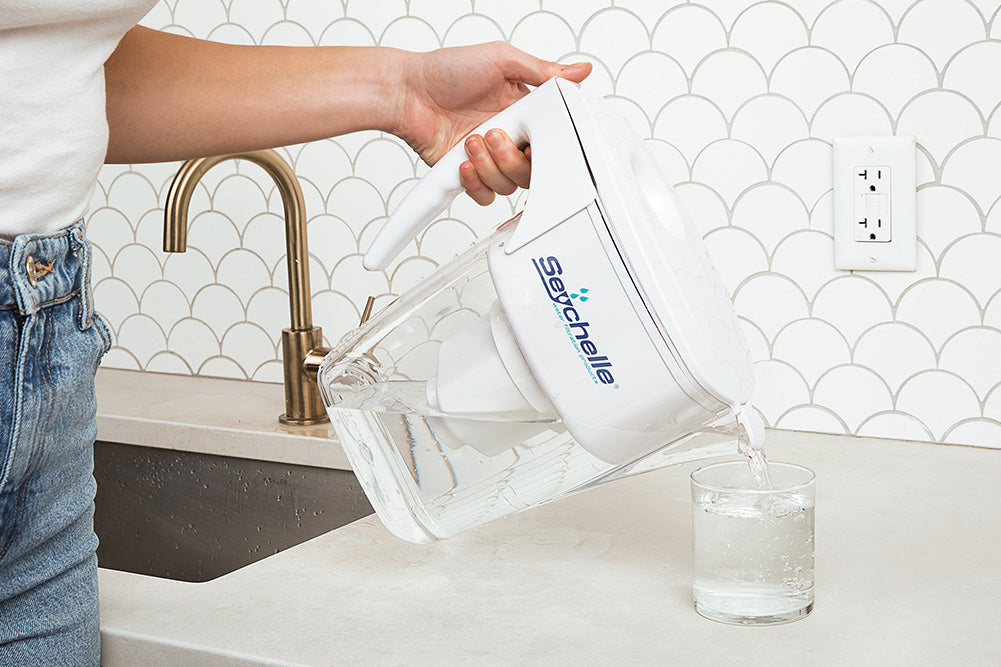Your Cart is Empty
February 08, 2024 4 min read

Ten years later - still hearing the word “lead” immediately conjures up images of sludgy, yellow water coming out of a sink in Flint, Michigan. The reason this crisis still holds such relevance is because lead is an extremely dangerous contaminant, and unknowingly consuming it can cause problems that will last a lifetime. Unfortunately, lead contamination is still occurring across the United States.
Lead is an element belonging to a group called “heavy metals.” Heavy metals are naturally occurring metals found in the earth’s crust and are high in toxicity. Lead is known for being soft and malleable, and it is used across industries and in many household items (1). Before its toxicity was better known, lead was used in paint, pipes, batteries, and ceramics, to name a few.
Unless your home is a new build, odds are that at one point it had lead pipes and faucets. Until 1986, lead pipes, faucets, and plumbing fixtures were installed in houses, and many of these fixtures were never replaced (2). To this day, these fixtures are the most common source of lead in drinking water. After years and years of water wearing down the pipes, the chemical process of corrosion occurs. As the lead pipes corrode, little flakes of metal enter the water that is then dispensed out in sinks.
While new homes no longer use lead piping, many older homes still have these pipes. The process to replace them is slow and expensive, and it is estimated that 6 to 10 million lead pipes still transport water into households, as well as other public businesses like schools and daycares. These pipes will corrode the more they are used, exposing more and more people to lead in their water.
Lead poisoning can occur when an individual is exposed to even small amounts of lead. Consuming and breathing in lead are both extremely toxic to all demographics, but it can affect some demographics more severely than others. For example, children are the most vulnerable to lead poisoning, and children under six are at a particularly high risk. According to the Environmental Protection Agency, “Even low levels of lead in the blood of children can result in: behavior and learning problems, lower IQ and hyperactivity, slowed growth, hearing problems, and anemia.”
Fetuses are also a high risk group, as lead can cross through the placenta and come in contact with the baby. This puts the mother at risk of a premature birth, and the fetus at risk of reduced growth.
Lastly, although adults are not as high risk as children, they can still experience the harmful effects of lead poisoning. High blood pressure, decreased kidney function, and reproductive issues are all long-lasting effects of lead exposure (3).
Due to its long list of harmful health effects, the EPA set its maximum contaminant level for lead in water at zero (2). This means that even traces of lead in your water is enough to be concerned over and take action.
Public water utilities are required to test their water sources for potential contaminants. If more than 10% of the homes they sample find lead in quantities more than 15 parts per billion, the company is required to take action (4). However, if less than 10% of the sampled households come across with lead in their water, no action is required. This means that these households are still vulnerable to lead in their water. The responsibility then falls on the homeowner to protect themselves from lead exposure.
In order to properly protect yourself from lead contamination, there are many options you can take. First, many water utilities encourage households to replace their lead pipes and faucets with new, safe alternatives. This would lessen the risk of exposure by way of corrosion, but replacing pipes is extremely costly.
A cost-effective alternative is letting the tap water run before using it (4). Allow the water to get cold before drinking it or using it for cooking, as cold water typically contains less lead than hot or boiling water. This process will not cost you anything, but it also does not guarantee your water will be lead-free.
The most effective and economic way to remove lead from your tap water is by using a water filter. There are many acceptable filters, but be sure that you find a filter that is independently lab-tested to remove lead. Seychelle’s radiological water filter, for example, is tested to remove up to 99.99% of inorganic contaminants like lead, ensuring that your water is safe to drink, every time.
Lead is a heavy metal that is found naturally in the environment. Before its toxicity was discovered, lead pipes were installed in the majority of households, and over time corrosion allowed lead from the pipes into the tap water. Despite regulations in place to fight lead contamination, millions of lead pipes are still in use, putting everyday people at risk. In order to ensure your water is not being contaminated with lead, try a Seychelle water filter. With Seychelle, you can sleep soundly at night knowing you and your family are drinking clean, lead-free water.
Can a filter remove lead from water?
Yes. However, not all water filters remove inorganic contaminants like lead from water, so it is important to ensure your water filter is independently lab-tested to remove lead from water.
How do you remove lead from water naturally?
You can lessen the amount of lead in your drinking water by letting cool tap water run before consuming it. However, to completely remove lead from your water, use a water filter.
Does boiling tap water remove lead?
No. Boiling tap water actually concentrates lead levels, making it even more dangerous.
References